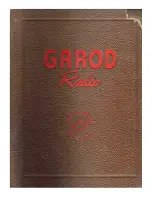
7
Circuit Description
Reception and transmission are switched by “RX-CNTL”
and “TX-CNTL” lines from the CNTL Unit. The receiver
uses double-conversion superheterodyne circuitry, with
a 21.4 MHz 1st IF and 450 kHz 2nd IF. The 1st local is
produced by a PLL synthesizer, yielding the 21.4 MHz
1st IF. The 2nd local uses a 21.850 MHz crystal oscillator,
yielding the 450 kHz 2nd IF. The 2nd mixer and other cir-
cuits use a custom IC to convert and amplify the 2nd IF
and detect FM to obtain demodulated signals. During
transmit, the PLL synthesizer oscillates at the desired fre-
quency directly, for amplification to obtain RF power out-
put. During transmit, voice modulation is applied to this
synthesizer. Transceiver functions, such as TX/RX control,
PLL synthesizer settings, and channel programming, are
controlled using the MPU.
Receiver
Incoming RF signals from the antenna connector are de-
livered to the RF Unit, and pass through a low-pass filter
(LPF) consisting of coils and capacitors, and antenna
switching diodes
D1003
and
D1004
(both
XB15A308
) for
delivery to the receiver front end.
Signals within the frequency range of the transceiver are
then passed through a bandpass filter consisting of T1001
and T1002 before RF amplification by
Q1014
(
2SC5006
).
The amplified RF is then bandpass filtered again by T1003,
T1004, and T1005, to ensure pure in-band input to 1st
mixer
Q1018
(
3SK320
).
Buffered output from the VCO Unit is amplified by
Q1016
(
2SC5006
) and bandpass filtered by L2012, C1072, and
C1078, to provide a pure 1st local signal between 134.65
and 140.625 MHz for delivery to the 1st mixer.
The 21.4 MHz 1st mixer product then passes through dual
monolithic crystal filter
XF2001
(±6.5 kHz BW), and is am-
plified by
Q1022
(
2SC4400-3
) and delivered to the input
of the FM IF subsystem IC
Q1024
(
TA31136FN
). This IC
contains the 2nd mixer, 2nd local oscillator, limiter am-
plifier, FM detector, noise amplifier, and squelch gates.
The 2nd local in the IF-IC is produced from crystal
X1001
(21.850 MHz), and the 1st IF is converted to 450 kHz by
the 2nd mixer and stripped of unwanted components by
ceramic filter
CF1001
.
After passing through a limiter amplifier, the signal is
demodulated by the FM detector. Demodulated receive
audio from the IF-IC is amplified by
Q1025
(
2SC4154E
),
then the signal is through the AF Mute switch
Q1027
(
TC4S66F
).
After volume adjustment by the AF power amplifier
Q1031
(
TDA2003
), the audio signal is passed to the exter-
nal Speaker terminal in the accessory cable and 16-Ohm
internal loudspeaker.
PLL Synthesizer
The 1st LO maintains stability from the PLL synthesizer
by using a 21.850 MHz reference signal from crystal
X1001
.
PLL synthesizer IC
Q1017
(
LV2105V
) consists of a pres-
caler, reference counter, swallow counter, programmable
counter, a serial data input port to set these counters based
on the external data, a phase comparator, and a charge
pump.
The PLL-IC divides the 21.850 MHz reference signal by
874 using the reference counter (25 kHz comparison fre-
quency). The VCO output is divided by the prescaler,
swallow counter and programmable counter. These two
signals are compared by the phase comparator and ap-
plied to the charge pump.
A voltage proportional to their phase difference is deliv-
ered to the low-pass filter circuit, then fed back to the VCO
as a voltage with phase error, controlling and stabilizing
the oscillating frequency. This synthesizer also operates
as a modulator during transmit.
The VCO is comprised of
Q1020
(
2SK210GR
) and
D1011
/
1012
, (both
1SV230
); it oscillates at 21.4 MHz during re-
ceive, and at the fundamental frequency during transmit,
with direct frequency-modulation using varactor diode
D1009
(
1SV214
). The VCO output passes through buffer
amplifier
Q1019
(
2SC5374
), and is amplified by
Q1016
(
2SC5374
) to obtain stable output. The VCO DC supply
is regulated by
Q1015
(
2SC4154E
). Synthesizer output is
fed to the 1st mixer by diode switch
D1007
(
DAN235U
)
during receive, and to drive amplifiers
Q1013
(
2SC5227-
4
),
Q1011
(
2SC3357
), and
Q1001
for transmit.
The reference oscillator feeds the PLL synthesizer.
Transmitter
Voice audio from the microphone is delivered via the
MIC
connector to the RF Unit. After passing through amplifier
Q1028
(
NJM2902M
), a pre-emphasis network, limiter
(IDC: instantaneous deviation control), and LPF
Q1028
(
NJM2902M
), the audio is adjusted for optimum devia-
tion level and delivered to the next stage.
Voice or DSC(Digital Selective Calling) encode signal in-
puts from the LPF
Q1028
is8 FM-modulated in the VCO
of the synthesizer. Synthesizer output, after passing
through diode switch
D1006
(
DAN235U
), is amplified by
driver
Q1013
(
2SC5227
),
Q1011
(
2SC3357
), and RF power
amplifier
Q1001
(
RA35H1516M
) to obtain full RF output.
The RF energy then passes through antenna switch
D1003
and a low-pass filter circuit and finally to the antenna con-
nector.
RF output power from the final amplifier is sampled by
C1006 and C1011 and is rectified by
D1002
(
1SS321
). The
resulting DC is fed through Automatic Power Control-
Summary of Contents for Quest GX1255S
Page 1: ...1 SERVICE MANUAL 25 Watt VHF FM Marine Transceiver QUEST GX1255S EM001N90A ...
Page 4: ...4 Note ...
Page 5: ...5 Block Diagram ...
Page 6: ...6 Connection Diagram ...
Page 14: ...14 MAIN Unit Note MAIN Unit ...
Page 24: ...24 CNTL Unit Note ...
Page 25: ...25 CNTL Unit Parts Layout B D F A C E 1 3 2 Side A DS2001 SEGMENT DS2001 COMMON ...
Page 31: ...13 ...








































